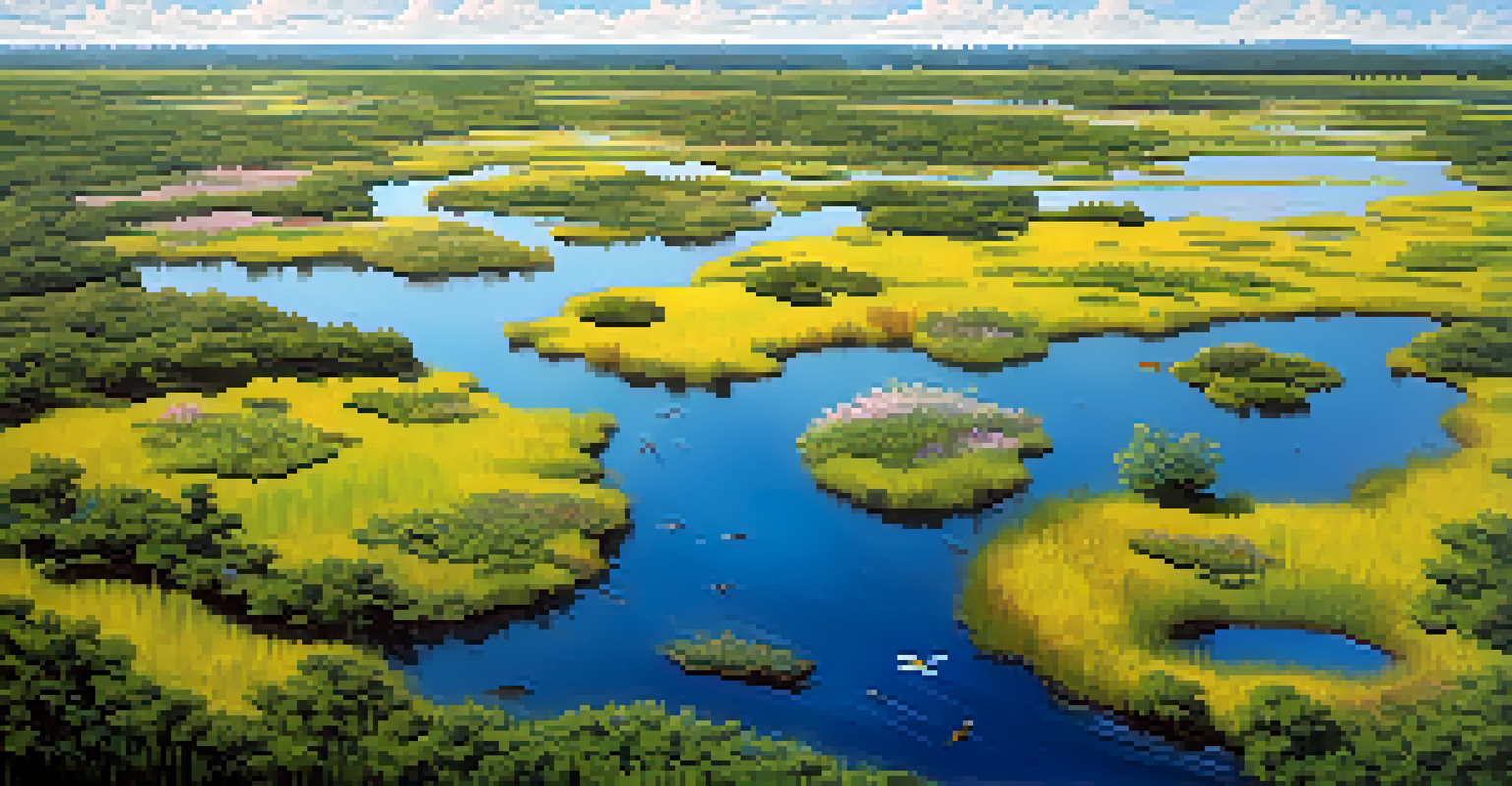Harnessing Wetlands for Climate Adaptation and Biodiversity

Understanding Wetlands and Their Importance
Wetlands are unique ecosystems where water meets land, creating a rich habitat for countless species. They include marshes, swamps, and bogs, each playing a crucial role in our environment. These areas are not just beautiful; they serve as natural buffers against flooding, improve water quality, and support carbon storage.
Wetlands are among the most productive ecosystems in the world, supporting a rich diversity of life and providing numerous ecological services.
By filtering pollutants and providing a habitat for wildlife, wetlands contribute significantly to biodiversity. They are home to a wide variety of plants and animals, some of which are rare or endangered. In fact, about 40% of the world’s species depend on wetlands for survival, showcasing their ecological importance.
Moreover, wetlands are essential for human communities as well. They provide resources such as fish and medicinal plants, and they offer recreational opportunities. Understanding their value helps us appreciate why preserving and restoring wetlands is vital for both nature and people.
Wetlands as Natural Climate Adaptation Tools
Wetlands act like sponges, absorbing excess rainwater and reducing the risk of flooding during heavy storms. This natural water management system is critical, especially as climate change leads to more extreme weather patterns. By maintaining healthy wetland ecosystems, communities can enhance their resilience to climate impacts.

In addition to flood control, wetlands also play a role in temperature regulation. They help cool nearby areas and can mitigate the urban heat island effect, making cities more livable. This natural cooling effect is becoming increasingly important as global temperatures rise.
Wetlands: Nature’s Flood Defense
Wetlands absorb excess rainwater, serving as natural buffers against flooding and enhancing community resilience to climate change.
Furthermore, wetlands are effective carbon sinks, sequestering carbon dioxide from the atmosphere. This ability to store carbon helps combat climate change, making wetlands not only beneficial for biodiversity but also essential for climate adaptation strategies.
Enhancing Biodiversity Through Wetland Restoration
Wetland restoration is a powerful way to enhance biodiversity. By rehabilitating degraded wetlands, we can revitalize habitats that support myriad species. This process often involves reintroducing native plants and ensuring clean water flow, creating a thriving ecosystem.
The health of our wetlands is directly tied to the health of our communities and the resilience of our environment.
Successful restoration projects can lead to significant increases in species populations. For example, restoring a marsh can bring back migratory birds, amphibians, and countless invertebrates, creating a vibrant web of life. The return of these species often indicates a healthy, functioning ecosystem.
Moreover, wetlands can serve as critical corridors for species migration, especially as habitats shift due to climate change. By restoring and connecting wetlands, we facilitate the movement of species, helping them adapt to new environmental conditions.
The Role of Local Communities in Wetland Conservation
Local communities play a vital role in the conservation and restoration of wetlands. Engaging communities ensures that conservation efforts are culturally relevant and sustainable. When locals take ownership of these projects, they are more likely to succeed and be maintained over time.
Education and awareness are key components in involving communities. By teaching the importance of wetlands and their ecological functions, individuals are empowered to take action. Workshops, school programs, and community events can all promote stewardship and conservation efforts.
Biodiversity Boost Through Restoration
Restoring degraded wetlands revitalizes habitats, increasing species populations and supporting ecological diversity.
Additionally, traditional knowledge can provide valuable insights into sustainable practices. Indigenous communities often have profound connections to their local wetlands, and their wisdom can guide effective conservation strategies. Collaborating with these communities fosters respect and enhances conservation outcomes.
Innovative Approaches to Wetland Management
Innovative management practices are essential for the sustainable use of wetlands. Techniques such as adaptive management allow for ongoing learning and adjustments based on what is most effective. These flexible strategies can help address the challenges posed by climate change and human activity.
Integrating technology into wetland management can also yield positive results. Remote sensing and GIS technologies can help monitor wetland health, track changes, and inform decision-making. These tools enable managers to make data-driven choices that benefit both the environment and local communities.
Moreover, using a collaborative approach that involves stakeholders from various sectors can lead to innovative solutions. By bringing together government agencies, NGOs, and the private sector, we can harness diverse perspectives and resources to enhance wetland management efforts.
Policy Frameworks Supporting Wetland Conservation
Effective policies are crucial for the protection and conservation of wetlands. Governments and organizations must create frameworks that prioritize wetland health, balancing development with ecological preservation. Policies should emphasize sustainable practices and provide incentives for conservation efforts.
International agreements, such as the Ramsar Convention, highlight the global importance of wetlands and encourage countries to take action. These agreements foster cooperation and provide guidelines for wetland management, ensuring that biodiversity and climate resilience remain priorities.
Community Engagement in Conservation
Local communities play a crucial role in wetland conservation, ensuring efforts are relevant, sustainable, and supported through education and traditional knowledge.
At the local level, zoning laws and land-use planning can safeguard wetland areas from encroachment. Implementing protective regulations helps maintain these vital ecosystems and promotes their restoration. Strong policy frameworks help create a supportive environment for wetland conservation initiatives.
The Future of Wetlands in Climate Adaptation Strategies
Looking ahead, wetlands must be integral to our climate adaptation strategies. As we face the escalating impacts of climate change, harnessing the natural benefits of wetlands is more important than ever. They provide solutions that are cost-effective and environmentally friendly, making them a smart choice for future planning.
Incorporating wetlands into urban planning can enhance city resilience and biodiversity. By designing green spaces that include wetland features, urban areas can benefit from improved water management and enhanced recreational opportunities. This integration creates vibrant communities while preserving nature.

Ultimately, the future of wetlands depends on our collective action. By prioritizing conservation, restoration, and sustainable management, we can ensure that these ecosystems continue to thrive, supporting both biodiversity and climate adaptation for generations to come.